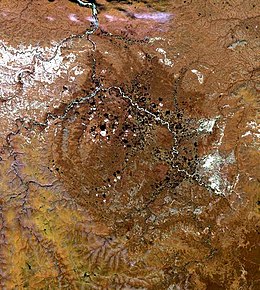| Popigai impact structure | |
|---|---|
 Landsat image of Popigai crater | |
| Impact crater/structure | |
| Confidence | Confirmed |
| Diameter | 90 km (56 mi) |
| Age | 35.7 ± 0.2 Ma Late Eocene |
| Exposed | Yes |
| Drilled | Yes |
| Bolide type | H chondrite |
| Location | |
| Coordinates | 71°39′N 111°11′E / 71.650°N 111.183°E |
| Country | Russia |
| State | Krasnoyarsk |

The Popigai impact structure is the eroded remnant of an impact crater in northern Siberia, Russia. It is tied with the Manicouagan structure as the fourth largest verified impact structure on Earth.[1][2] A large bolide impact created the 100-kilometre (62 mi) diameter crater approximately 35 million years ago during the late Eocene epoch (Priabonian stage).[3][4] It might be linked to the Eocene–Oligocene extinction event.[5]
The structure is 300 km (190 mi) east from the outpost of Khatanga and 880 km (550 mi) northeast of the city of Norilsk, NNE of the Anabar Plateau. It is designated by UNESCO as a Geopark, a site of special geological heritage.[6] There is a small possibility that the Popigai impact crater may have formed simultaneously with the approximately 35-million-year-old Chesapeake Bay and Toms Canyon impact craters.[3]
For decades, the Popigai impact structure has fascinated paleontologists and geologists, but the entire area was completely off limits because of the diamonds found there. However, a major investigatory expedition was undertaken in 1997, which greatly advanced understanding of the structure.[6] The impactor is suggested to have been a H chondrite asteroid based on ejecta layers from Italy, with the impactor thought to have been several kilometeres in diameter.[7]
The shock pressures from the impact instantaneously transformed graphite in the ground into diamonds within a 13.6 km (8.5 mi) radius of the impact point. These diamonds are usually 0.5 to 2 mm (0.020 to 0.079 in) in diameter, though a few exceptional specimens are 10 mm (0.39 in) in size. The diamonds inherited the tabular shape of the original graphite grains and also the original crystals' delicate striations.[6]
- ^ "Popigai". Earth Impact Database. Planetary and Space Science Centre University of New Brunswick Fredericton. Retrieved 2017-10-09.
- ^ Masaitis, Victor L. (2003). Popigai Crater: General Geology. Springer. pp. 81–85. ISBN 978-3-540-43517-4.
- ^ a b Deutsch, Alexander; Christian Koeberl (2006). "Establishing the link between the Chesapeake Bay impact structure and the North American tektite strewn field: The Sr-Nd isotopic evidence". Meteoritics & Planetary Science. 41 (5): 689–703. Bibcode:2006M&PS...41..689D. doi:10.1111/j.1945-5100.2006.tb00985.x.
- ^ Armstrong, Richard; S. Vishnevsky; C. Koeberl (2003). U-Pb Analysis of zircons from the Popigai impact structure, Russia: First Results. Springer. pp. 99–116. ISBN 978-3-540-43517-4.
- ^ "Russia's Popigai Meteor Crash Linked to Mass Extinction". Live Science. June 13, 2014.
- ^ a b c Deutsch, Alexander; V.L. Masaitis; F. Langenhorst; R.A.F. Grieve (2000). "Popigai, Siberia—well preserved giant impact structure, national treasury, and world's geological heritage". Episodes. 23 (1): 3–12. doi:10.18814/epiiugs/2000/v23i1/002.
- ^ Schmitz, Birger; Boschi, Samuele; Cronholm, Anders; Heck, Philipp R.; Monechi, Simonetta; Montanari, Alessandro; Terfelt, Fredrik (September 2015). "Fragments of Late Eocene Earth-impacting asteroids linked to disturbance of asteroid belt". Earth and Planetary Science Letters. 425: 77–83. Bibcode:2015E&PSL.425...77S. doi:10.1016/j.epsl.2015.05.041.
